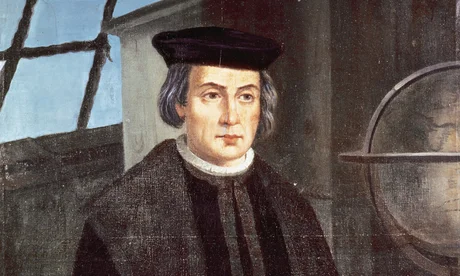A groundbreaking study has surfaced fascinating new details about Christopher Columbus, suggesting he was of Jewish descent and originally from Western Europe.
This revelation comes after extensive research that focused on his remains, discovered over 500 years posthumously.
A Long-Standing Debate
The true origins of Columbus, the famed 15th-century explorer who initiated Spanish-funded expeditions starting in the 1490s, have always sparked debate among historians.
While the conventional view is that he hailed from Genoa, Italy, alternative theories propose various origins, including Jewish roots, Greek ancestry, or even Basque, Portuguese, or British heritage.
To clarify this historical enigma, a team of researchers, led by forensic expert Miguel Lorente, embarked on a comprehensive 22-year investigation.
They examined minute samples from remains believed to be Columbus’s, buried in Seville Cathedral.
This site has long been recognized as his final resting place, although there have been competing claims suggesting he might have been laid to rest in the Dominican Republic.
Genetic Testing Uncovers Jewish Traits
The findings were unveiled in a documentary titled Columbus DNA: The True Origin, aired recently on Spain’s national broadcaster, TVE.
“We have DNA from Christopher Columbus, very partial, but sufficient. We also have DNA from Hernando Colón, his son,” Lorente shared in the program.
He noted that both the Y chromosome and mitochondrial DNA from Hernando showed traits consistent with Jewish ancestry.
Historically, around 300,000 Jews lived in Spain before the Catholic Monarchs, Isabella and Ferdinand, issued edicts forcing Jews and Muslims to convert to Christianity or leave the country.
Many of these exiled Jews went on to establish communities around the globe, and the term “Sephardic” stems from “Sefarad,” the Hebrew word for Spain.
A Western European Birthplace
After investigating 25 potential birthplaces, Lorente concluded that Columbus was likely born in Western Europe.
Last Thursday, he reaffirmed earlier theories that the remains housed in Seville Cathedral indeed belong to Columbus.
Although research into Columbus’s nationality posed various challenges, Lorente expressed confidence in the reliability of the outcome.
Columbus passed away in Valladolid, Spain, in 1506, but had expressed a wish to be buried on the island of Hispaniola, which today is shared by the Dominican Republic and Haiti.
His remains underwent several relocations—first moved to Cuba in 1542 and eventually believed to have arrived in Seville in 1898.
Thanks to modern technologies, Lorente and his team confirmed the longstanding belief that the Seville Cathedral holds Columbus’s remains.
A Journey of Discovery
Columbus embarked on his historic voyage on August 3, 1492, setting sail from Palos, Spain, in search of a route to the treasures of Asia.
Accompanied by three ships—Nina, Pinta, and Santa Maria—and around 100 men, he ventured into the unknown.
On October 12, 1492, the expedition reached the Bahamas, followed by Columbus mistaking Cuba for mainland China later that month, and later landing in what he believed to be Japan.
During his second voyage in 1493, Columbus returned to the New World, landing in Puerto Rico, where he enslaved many of the Taino people.
Over the next four years, the arrival of many Spanish settlers led to the devastating decline of the Taino population, with estimates indicating around seven million deaths, accounting for approximately 85 percent of their numbers.
The Spread of Disease
The arrival of Europeans also facilitated the spread of deadly diseases such as smallpox and measles.
Some historians argue that Columbus was responsible for introducing syphilis-like diseases to the Americas.
However, a study released in January indicated that such diseases were already widespread thousands of years prior to Columbus’s arrival.
The first documented outbreak of syphilis in Europe occurred in the late 15th century, leading many to believe it was transported to America when Columbus landed.
However, recent DNA evidence indicates that treponematosis, a syphilis-like illness, existed in Brazil more than 2,000 years before Columbus’s voyage.
Uncovering Ancient Diseases
Kerttu Majander, a postdoctoral researcher at the University of Basel, noted that the findings represent an endemic type of treponemal disease, distinct from sexually transmitted syphilis, leaving the origins of the latter still unresolved.
The research involved examining the remains of four individuals from the Santa Catarina coastal region in Brazil, dating back thousands of years, which displayed signs of a treponemal disease likely causing mouth sores and shin pain.
Published in Nature, the study analyzed bones excavated from the Jabuticabeira II archaeological site since 2016.
Researchers screened 37 out of 99 samples and found a significant presence of pathogens from the Treponema family.
Verena Schünemann, a co-author of the study, remarked, “Although the origin of syphilis still leaves room for imagination, we now know for certain that treponematoses were not foreign to the American inhabitants long before Europeans explored the continent.”
What Lies Ahead?
As we unravel more about Columbus’s identity and the health of the ancient Americas, it raises essential questions about our historical narratives and the interconnectedness of cultures.
What will future research reveal about our past? Only time will tell.
